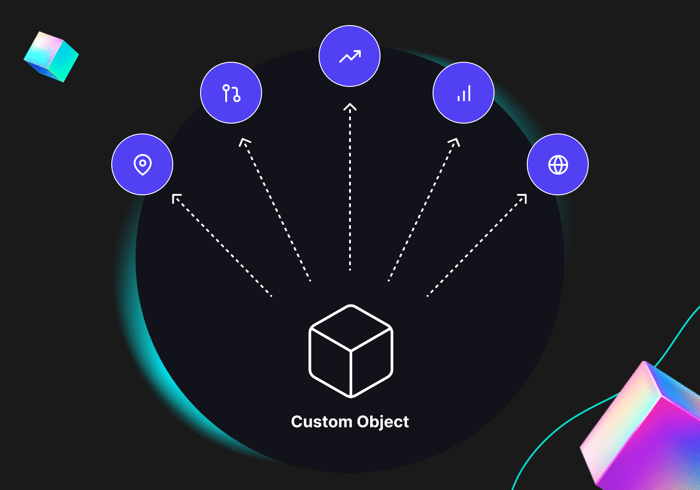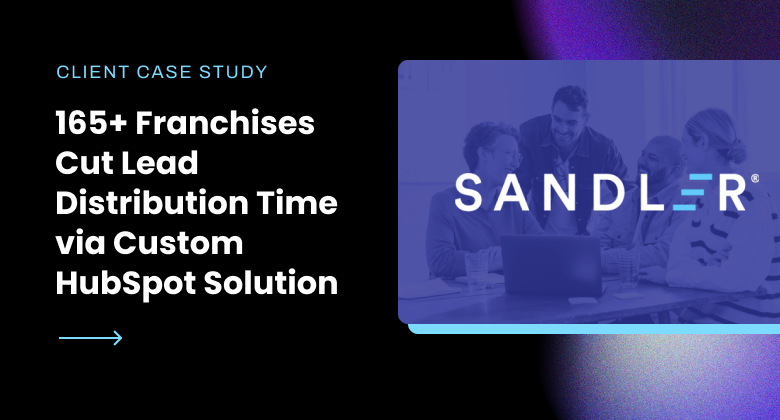HubSpot Integrations Technology
Guide to Maximizing Your HubSpot CRM Integration for Technical and Business Optimization
11/12/2024 • 18 min read • Written by Lynton Team
Table of Contents
Disparate systems create fractured customer experiences and inefficient operations. When your marketing team can't see sales data, your service team lacks customer context, and your executives struggle to measure ROI, it's time to unite your business systems. A properly implemented HubSpot CRM integration transforms these disconnected pieces into a robust, unified ecosystem that drives growth and efficiency.
This blog will walk you through essential practices for optimizing your HubSpot CRM integration, from technical implementation strategies to organizational adoption. Whether planning your first integration or looking to enhance existing connections, you'll discover proven approaches based on hundreds of successful implementations.
Why HubSpot CRM Integration Matters
A HubSpot CRM integration serves as the digital nervous system of your organization, creating automated data flows between systems (i.e., your marketing automation and CRM/ERP or other platform) and enabling smart, data-driven operations. This isn't simply about connecting software by having objects and fields flow from one system to another and vice versa — it's about creating a single source of truth that empowers every team member to make informed decisions and deliver exceptional customer experiences.
When implemented correctly, a HubSpot CRM integration delivers impactful benefits, including:
- Unified customer view that eliminates data silos and provides complete visibility into customer journeys
- Automated data synchronization that reduces manual entry and minimizes costly human errors
- Enhanced decision-making through comprehensive, real-time reporting across all business units
- Improved team collaboration through shared access to customer insights and interaction history
- Streamlined workflows that automate repetitive tasks and free up time for strategic work
- Consistent, personalized customer experiences driven by complete, accurate data
- Scalable operations that can grow without requiring significant system overhauls
At Lynton, we develop integrations in response to specific business needs, not for the sake of connecting systems. Each integration is tailored to address our clients' unique challenges.
Anastasia Zhukova
HubSpot Solutions Engineer
Lynton
Technical Practices for Optimizing HubSpot CRM Integration
The success of your HubSpot CRM integration hinges on technical decisions made during implementation and ongoing maintenance. Let's explore the critical components ensuring your integration delivers maximum value while avoiding common pitfalls derailing your success.
Data Mapping for Success
Data mapping forms the foundation of every successful integration, yet it's where many organizations stumble by rushing toward end results without proper planning. At Lynton, our integration specialists regularly see clients eager to jump straight to reporting or automation before establishing crucial data groundwork — an approach often leading to rebuilds and inefficiencies.
For instance, non-technical stakeholders, such as a marketing executive or a CMO, may come in with a specific request to see financial data in HubSpot, focusing solely on the desired result without understanding the steps to get there. While knowing the "what" is essential, achieving it requires a strategic approach to data flow, field types, and compatibility. Bridging this gap through collaborative planning between technical and non-technical teams is crucial to create a practical integration roadmap.
Here's how to approach that data mapping strategically:
- Start with clear objectives:
- Define exactly what data needs to flow between systems and why
- Consider future scalability – what additional data might you need in 6-12 months?
- Document specific use cases from all stakeholders (marketing, sales, service teams)
- Establish clear rules for data ownership and a system of record (note: your CRM will typically be your "single source of truth").
- Define update frequencies and sync triggers
- Map out dependent processes and downstream impacts
- Catalog your data sources:
- Map out all systems containing relevant data
- Identify field types and their limitations/capability (e.g., o[en text fields cannot map to dropdown options)
- Document naming conventions and data formats across systems
- Create a data dictionary that explains field meanings and usage
- Identify required vs. optional fields in each system
- Note any system-specific data validation rules
- Create a comprehensive mapping strategy:
- Define primary keys and relationships between objects
- Address field type compatibility challenges
- Establish rules for data transformation and standardization
- Plan for batch processing to handle large data volumes
- Define conflict resolution rules for bi-directional syncs
- Create clear data flow diagrams
- Implement thorough documentation:
- Create detailed mapping documents accessible to all stakeholders
- Include specific field options and limitations
- Maintain version control for all changes
- Document the rationale behind mapping decisions
- Create visual guides for complex data flows
- Include troubleshooting guides for common scenarios
Building a data dictionary that lists field names, types, definitions, and uses ensures everyone involved in the integration process clearly understands the data and its flow. Such documentation helps avoid misinterpretation and provides continuity, especially if different team members handle maintenance.
For example, in various integrations, you may encounter a situation where a single contact in HubSpot needs to map four different contact types in your CRM or other system. With a data dictionary and flow diagrams, you'll understand these data relationships upfront, prevent data mismatches, and ensure accurate reporting across both systems.
Leveraging the HubSpot API
For many businesses, leveraging the HubSpot API is a crucial step toward maximizing the power of their CRM integration. An API, or Application Programming Interface, acts as a bridge between different software systems, enabling them to interact effectively. When HubSpot's out-of-the-box functionality isn't enough to meet your business needs, such as integrating with niche applications, managing custom workflows, or automating complex processes, the HubSpot API becomes invaluable.
The HubSpot API allows for secure data management within HubSpot through data retrieval requests (GET) and data update requests (POST), providing the capability to retrieve, create, and update data programmatically. It also supports webhooks, which deliver real-time notifications when certain events occur, ensuring your business operations are always up to date. Efficient use of the HubSpot API requires a thorough understanding of essential elements like authentication methods, rate limits, and error handling.
Consider a recent integration project involving NetSuite and HubSpot. Our client initially tried using HubSpot's native mapping capabilities, which worked for basic needs, but they wanted to incorporate additional, more specific data sets that required custom API calls. Like planning a road trip where some roads are open, and others are closed, navigating an integration requires checking the available paths through API documentation to confirm which information can be retrieved or updated. Because we understand the API's limitations and opportunities, we can successfully expand the data flow beyond native functionality, providing the client with a more holistic data view.
To make the most out of the HubSpot API, here are some optimization tips and common pitfalls to avoid:
- Rate Limiting and Batching: Implement proper batch sizes (the number of calls you can make is based on your account subscription and if you’ve purchased an API limit increase) and space out data transfers to prevent overload. Build in delay times between batches and monitor API quota usage to stay within rate limits and ensure seamless data flow.
- Authentication: Proper authentication is crucial. The HubSpot API supports several methods, including OAuth, for enhanced security and permission management. Secure API key management, regular security audits, and choosing the right authentication method for your use case keep data safe and ensure access is limited to authorized users.
- Error Handling: Overlooking error responses can lead to significant integration issues. Always implement robust error-handling mechanisms, including retries and alerts for any failures. Set up comprehensive error-catching systems, document common error scenarios, and create resolution protocols. During a Salesforce integration, for example, we encountered mismatched dropdown options between Salesforce and HubSpot, leading to errors. Implementing proper monitoring allowed us to adjust field mappings and efficiently and promptly resync data.
- Monitor Performance: Neglecting to monitor API performance can degrade functionality over time. Metrics like response time, failure rates, and rate limits are vital for maintaining consistent performance. Regular monitoring can reveal issues before they escalate, allowing your team to take corrective action proactively.
Thorough Integration Testing
Testing your HubSpot CRM integration is critical in ensuring a smooth launch and avoiding issues that can disrupt your workflows. It provides the opportunity to identify and resolve potential problems before they impact your operations, ensuring your integration works seamlessly from day one. Thorough testing also builds confidence across teams, knowing that each integration aspect has been rigorously evaluated.
We recommend three tired-and-true testing approaches that catch issues before they impact your business:
- Unit Testing: This involves verifying individual components or functions of the integration. By testing each piece of code separately, you can catch errors at a granular level and ensure that every element performs as intended, contributing to the overall reliability of the integration.
- User Acceptance Testing (UAT): UAT is vital for validating the integration from the end-user perspective. It involves actual users interacting with the system to confirm it meets their needs and that the user experience aligns with expectations. A recent project that integrated multiple systems involving end users from different departments early in the testing process helped identify discrepancies in how various teams expected the CRM to function, ultimately preventing costly adjustments post-launch.
- Regression Testing: As you update or add new features, regression testing ensures these changes haven't unintentionally affected existing functionality. This step is crucial for maintaining a stable integration environment, especially when multiple systems and workflows are interconnected. Regular regression tests ensure that past features operate smoothly, allowing new updates to enhance rather than hinder your CRM.
When we work on HubSpot CRM integrations, we collaborate closely with clients during UAT by providing structured testing scenarios. This approach serves two purposes: validating the integration and training users on proper data handling procedures. We've found this dramatically improves user adoption and reduces support tickets.
Ongoing Monitoring and Maintenance
Monitoring your HubSpot integration is not a one-time task. It's a continuous process that ensures long-term success. Maintaining a well-functioning integration is essential for preserving data quality and enhancing performance across sales, marketing, and customer service.
That's because data quality directly affects all departments. If sales teams receive outdated or incorrect customer information, it can lead to missed opportunities. Similarly, marketing campaigns driven by inconsistent data might fail to connect with the intended audience. Effective monitoring practices can help prevent such scenarios and keep your data accurate and actionable.
These are some examples of tools and strategies to build a proactive maintenance culture:
- HubSpot Reports: Utilize HubSpot reports to catch errors and inconsistencies in your data. Set up automated reports that track data flows and highlight irregularities. During a recent integration project, we identified a sudden spike in leads, revealing an automation issue that required immediate attention to prevent inaccurate data from propagating.
- Feedback Surveys: Implement feedback surveys to gather input from users, ensuring they aren't facing challenges that might indicate deeper integration issues. Regular user insights can uncover hidden inefficiencies and drive future improvements.
- Error Notifications: Set up real-time error notifications to alert your team when integration issues arise, allowing immediate corrective action. This proactive approach ensures minor problems are addressed before they become major disruptions.
However, partnering with an experienced integration specialist is a solid option if you need help to monitor an integration. A trusted partner offers support and monitoring packages that address potential issues before they escalate and ensure that your integration stays optimized as your needs evolve. If you’re interested in learning more about what our custom integration services look like, please reach out to talk with an expert.
Non-Technical Practices for Optimization
Optimizing a HubSpot CRM integration goes beyond technical configurations; it also requires thoughtful, non-technical practices to ensure adoption, usability, and alignment with organizational goals. A successful integration depends on how well it is embraced by the people using it daily. Below, we explore critical non-technical practices to help you get the most out of your HubSpot CRM integration.
Comprehensive User Training
Comprehensive training is one of the most critical non-technical aspects of successful integration. It encourages user adoption and ensures everyone can effectively leverage the integrated CRM. Training should be an ongoing process that adapts to the evolving needs of the users, creating a knowledgeable team that can fully utilize the integration's capabilities.
Examples of comprehensive user training may include the following:
- A Structured Onboarding Program: A structured onboarding program helps new users get acquainted with the integration, ensuring they understand how to use it effectively. This foundational knowledge reduces the learning curve and accelerates adoption.
- Hands-On Training Sessions: Interactive training sessions allow users to practice critical workflows actively. During an integration involving a complex data setup, we found that users who participated in hands-on sessions were significantly more confident and effective in using the system than those who only received written documentation.
- Access to Learning Resources: Provide access to user manuals, FAQs, and HubSpot's knowledge base to support self-paced learning. This ensures users have resources at their fingertips to solve issues independently, fostering a proactive approach to problem-solving.
- Regular Feedback: Gather regular feedback from users to improve the training process and address any knowledge gaps. Creating a culture where feedback is encouraged will help keep training relevant and effective over time, ensuring that the integration evolves alongside user needs.
Encouraging Cross-Department Collaboration
Cross-department collaboration ensures that every team, whether sales, marketing, or customer service, is aligned in their understanding and use of the CRM. Promoting open communication and breaking down silos between departments helps facilitate this alignment. Meetings, where different teams discuss CRM use and share best practices, foster a culture of learning and collective problem-solving. In all of our past integration projects, encouraging open communication helped teams understand each other's pain points and align their strategies for better outcomes.
Establishing feedback loops is another crucial element of cross-department collaboration. Insights from one department can significantly enhance workflows in other areas, thereby improving overall efficiency. For example, during a tailored ERP integration with a client, aligning definitions of customer data across sales, marketing, and service teams helped prevent future miscommunication and errors. This alignment led to a more seamless operation, as feedback was actively gathered and acted upon, enhancing the CRM experience for everyone involved.
Defining Clear Objectives and KPIs
Setting clear objectives and KPIs is essential to track the success of your HubSpot CRM integration. Objectives provide a sense of direction, while KPIs offer a way to measure progress and success. Before launching your integration, it is crucial to establish measurable outcomes that define what success looks like. Examples include adoption rates, data accuracy metrics, or sales cycle times — these KPIs help gauge whether the integration meets its intended goals.
Regularly monitoring KPIs allows you to adapt your strategies as needed. For instance, if user adoption rates are lower than expected, additional training sessions or user incentives may be necessary to boost engagement. By staying agile and responsive to KPI insights, you can ensure that your integration evolves in line with organizational needs and continues to add value. This dynamic approach ensures the integration remains aligned with business outcomes and effectively drives growth.
Documentation of Processes and Best Practices
Proper documentation is the backbone of successful integration management. It keeps all stakeholders informed and ensures consistency in how the CRM is used across the organization. Adequate documentation minimizes confusion and provides clarity, serving as a reliable reference point for everyone involved. Effective documentation practices you may want to consider include:
- Building a Clear Structure: Keep your documentation well-structured and easy to navigate so users can quickly find what they need. A clear, organized format makes it more likely for users to consult the documentation when encountering an issue.
- Keeping It Up to Date: Maintain version control and update documents whenever integration changes occur. This ensures everyone is working with the most current information, reducing the risk of errors due to outdated guidelines.
- Encouraging Contributions: Allow users to contribute to documentation, helping to keep it relevant and comprehensive. User input can often provide valuable insights into how the system is being used and highlight areas needing clarification.
- Using Visual Aids: Diagrams and flowcharts can help users visualize data flows and understand processes better. During a HubSpot-NetSuite integration, we used comprehensive data dictionaries and flowcharts to clarify the flow of customer data between both systems, preventing misunderstandings and ensuring consistency.
Gathering and Implementing User Feedback
User feedback is invaluable for the continued improvement of your CRM integration. Engaging with users helps uncover issues and identify opportunities for enhancement. Actively seeking user input encourages a sense of ownership and ensures that the integration evolves to meet actual needs. Here are some suggested ways to gather and implement user feedback:
- Create Feedback Channels: Develop channels for ongoing feedback, such as surveys, dedicated Slack channels, or suggestion boxes within your CRM. This gives users a direct line to share their experiences and suggestions, ensuring their voices are heard.
- Encourage User Input: Make it clear that all feedback is welcome and will be used to improve the integration experience. Actively seeking input fosters a sense of ownership and collaboration, making users feel that their contributions matter.
- Act on Feedback: Implement changes based on user feedback to demonstrate that their input matters and encourage more participation in the future. For instance, after receiving feedback during a complex integration, we modified specific workflows to be more intuitive, increasing satisfaction and efficiency.
Real-World Examples of HubSpot Integrations
The transformative power of HubSpot integrations is best illustrated through real-world examples. These stories demonstrate the practical benefits of integration and serve as blueprints for organizations aiming for similar success. They include some of our top success stories, such as:
- The Rock & Roll Hall of Fame: By integrating their CRM with HubSpot, the Rock & Roll Hall of Fame streamlined its marketing campaigns, leading to increased engagement and a more efficient lead nurturing process. The integration helped unify disparate data sources, enabling the team to create more cohesive and personalized marketing strategies.
- CCB Technology: As a nationwide IT services provider, CCB Technology faced challenges in unifying ConnectWise CRM data with HubSpot. By working with SyncSmart, Lynton's product brand, they established a bidirectional sync that enhanced data management, real-time data flow, and marketing automation, making their campaigns significantly more efficient. The improved data flow allowed CCB Technology to run more targeted campaigns, ultimately driving higher lead conversion rates.
The Final Word
Integrating and optimizing HubSpot CRM is about more than just getting the technology right — it's about empowering your entire organization to work smarter and more collaboratively. When you focus on technical practices, such as leveraging the HubSpot APIs and implementing thorough testing and non-technical approaches like user training and cross-department collaboration, you set your CRM up to drive business growth.
Don't let your CRM integration be just another project. Let it be the catalyst for elevating your entire business. Connect with our team today, and we’ll help you achieve seamless and impactful integration success.
By: Lynton Team
Lynton is an innovation agency with over 25 years of digital experience, helping organizations tackle marketing challenges, embrace new technologies, and drive growth. We combine creative strategy with technical expertise to build smarter websites, integrate systems, and turn data into actionable results.
You May Also Like

Integrations
What to Know About Out-of-the-Box Integrations vs. Custom Integrations
Do you need an out-of-the-box or custom integration? Discover what's involved in each and how your company should choose betw...
Keep Reading
Email Marketing
Guide to Building a Successful Abandoned Cart Recovery Campaign
Maximize e-commerce revenue with an effective abandoned cart recovery strategy with personalization, technical setup & ot...
Keep Reading
Integrations
Guide to Using the HubSpot API
Unlock the power of HubSpot API to enhance CRM, automate marketing, and streamline support. Tips and best practices for devel...
Keep ReadingSubscribe Today

